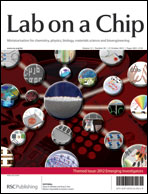Fusion and sorting of two parallel trains of droplets using a railroad-like channel network and guiding tracks†‡
Abstract
We propose a robust droplet fusion and sorting method for two parallel trains of droplets that is relatively insensitive to frequency and phase mismatch. Conventional methods of droplet fusion require an extremely precise control of aqueous/oil flows for perfect frequency matching between two trains of droplets. In this work, by combining our previous two methods (i.e., droplet synchronization using railroad-like channels and manipulation of shape-dependent droplets using guiding tracks), we realized an error-free droplet fusion/sorting device for the two parallel trains of droplets. If droplet pairs are synchronized through a railroad-like channel, they are electrically fused and the fused droplets transit to a middle guiding track to flow in a middle channel; otherwise non-synchronized non-fused droplets will be discarded into the side waste channels by flowing through their own guiding tracks. The simple droplet synchronization, fusion, and sorting technology will have widespread application in droplet-based chemical or biological experiments, where two trains of the chemically or biologically treated or pre-formed droplets yield a train of 100% one-to-one fused droplets at the desired outlet channel by sorting all the non-synchronized non-fused droplets into waste outlets.

- This article is part of the themed collection: 2012 Lab on a Chip Emerging Investigators

 Please wait while we load your content...
Please wait while we load your content...